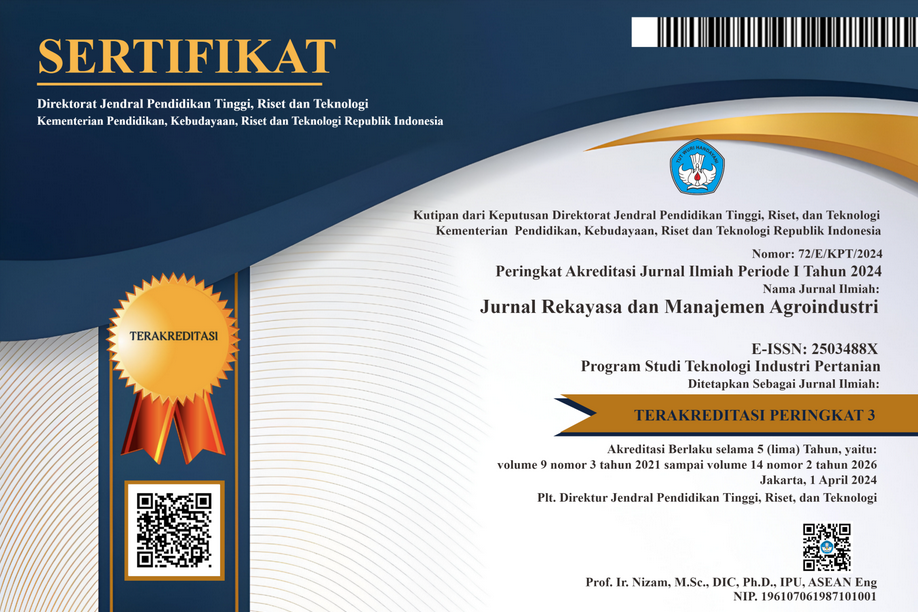Pengaruh Konsentrasi Bahan Penguat terhadap Karakteristik Komposit Bioplastik Pati Talas (Xanthosoma sagittifolium) dan Kitosan
Abstract
Taro starch is a carbohydrate contained in plants, especially chlorophyll plants. Naturally, starch contains amylose and amylopectin. Amylose gives a hard nature and gives a dark blue color on the iodine test, while amylopectin causes a sticky nature and does not cause a reaction. Chitosan is a linear polysaccharide consisting of the monomers N-acetylglucosamine (GlcNAc) and D-glucosamine (GlcN). Chitosan has the general formula (C6H9NO3)n or is referred to as poly(ß(1,4)-2-amino-2-Deoxy-D-glucopyranose). This study aims to determine the effect of the concentration of polyvinyl alcohol and polycaprolactone on the characteristics of the taro starch and chitosan bioplastic composites which produce the best bioplastic composites. This study used a randomized block design (RAK) with 6 treatments consisting of 3 levels of polyvinyl alcohol concentration and 3 levels of polycaprolactone concentration of 0%, 5% and 10% with taro starch and chitosan as raw materials 60:40. Each treatment was grouped into 3 based on the time of the bioplastic manufacturing process, so there were 18 experimental units. The variables observed were tensile strength, elongation at break, elasticity (Young's modulus), WVTR, swelling and biodegradation. The data were analyzed by analysis of variance (ANOVA) and continued with the Honest Significant Difference test if there was a significant effect. The results showed that the concentration of reinforcing material had a very significant effect on the characteristics of tensile strength, elongation at break, elasticity (Young's modulus), WVTR, swelling and biodegradation of taro starch and chitosan bioplastic composites. The best characteristic of taro starch and chitosan bioplastic composites was the concentration treatment of 10% polyvinyl alcohol with the greatest tensile strength 13.85 MPa, elongation at break 8.46%, elasticity 2.83 MPa, swelling 66.81%, WVTR 1, 85 g/m2day and biodegradation time for 7 days.
Keywords: bioplastic composites, concentration, taro-chitosan starch, polyvinyl alcohol and polycaprolactone
Downloads
References
Averous, L. 2004. Biodegradable multiphase systems based on plasticizer starch. J. Macromol Sci. 12(2):123-130.
Azmi, N., Abu B. A., Samsuddin S. A. dan Abdul A. N. A. 2014. Preparation and Characterization of Tapioca Starch Filled Polycaprolactone Composite Films. The Malaysian Journal of Analytical Sciences. 18(3): 612-617
Darni, Y. dan H. Utami. 2009. Studi Pembuatan dan karakteristik dari pati buah lindur (Bruguiera Gymnorrhiza). Jurnal fishtech, 7(1),49-59
Fajri, G., Hasan dan M. Zulfadli. 2017. Pembuatan dan Karakterisasi Bioplastik dari Kitosan, Pati Talas (Colocasia esculenta) dan Minyak Jarak. 2(3),211-219
Habibi, Y., Lucia L. A., Schiltz N., Duquesne E., Dubois P. dan Dufresne A. 2008. Bionanocomposites Based On Poly(ɛ-Caprolactone)-Grafted Cellulose Nanocrystals by Ring-Opening Polymerization. Journal of Materials Chemistry. 18:5002-5010.
Harsojuwono, B. A., I. W. Arnata dan S. Mulyani. 2017. Biodegradable plastic characteristics of cassava starch modified in variations temperature and drying time. Chemical and Process Engineering Research. 49: 1-5
Hasanah, Y. R. dan Haryanto. 2017. Pengaruh penambahan filler kalsium karbonat (CaCO3) dan clay terhadap sifat mekanik dan biodegradable plastik dari limbah tapioka. Jurnal Techno. 18(2): 096-107.
Hasibuan, M. E. 2018. pembuatan dan karakteristik biokomposit polikaprolakton (PCL) / pati sukun. Skripsi S1. Tidak dipublikasikan. Fakultas Matematika dan Ilmu Pengetahuan Alam, Universitas Sumatera Utara, Medan.
Indrawati, C., B. A. Harsojuwono dan A. Hartiati. 2019. Karakteristik komposit bioplastik glukomanan dan maizena dalam pengaruh variasi suhu dan waktu gelatinisasi. Jurnal Rekayasa dan Manajemen Agroindustri. 7(3): 468-477.
Jacoeb, A. M., R. Nugraha dan S. P. S. D. Utari. 2014. Pembuatan edible film dari pati buah lindur dengan penambahan gliserol dan karaginan. Jurnal Hasil Perairan. 17(1): 34-46
Jie, L., Quangtrong N., Jiqing Z., dan Zheng-Hua P. 2003. Polyvinyl Alcohol/ polyvinil pyrrolidone Interpenetrating Polymer Network: Synthesis and Pervaporation Properties, Journal of Applied Polymer Science. Vol. 89, 2808-2814.
Kimia, D., Matematika, F., Ilmu, D. A. N., dan Alam, P. 2013. Pencirian bioplastik tepung tapioka terplastisasi gliserol dengan penambahan karagenan muhammad bagja sogiana.
Kumar, M. N. V. 2000. Review of Chitin and Chitosan Application. Reactive & Functional Polymers. Pergamen Press. Oxford. 46(1): 1-27.
Mindarwati, E. 2016. Kajian Pembuatan Edible Film Komposit dari Karagenan sebagai Pengemas Bumbu Mie Instan Rebus. Tesis. Sekolah Pascasarjana IPB, Bogor.
Nair, L. S. dan Laurencin C. T. 2007. Biodegradable Polymers as Biomaterials Journal Of Progress In Polymer Science.
Purnavita, S. 2021. Kajian Ketahanan Bioplastik Pati Jagung Dengan Variasi Berat Dan Suhu Pelarutan Polivinil Alkohol. Journal of Chemical Engineering. Vol. 2:14-18
Saputra, W., A. Hartiati dan B. A. Harsojuwono. 2019. Pengaruh Konsentrasi Seng Oksida (ZnO) Dan Penambahan Gliserol Terhadap Karakteristik Bioplastik Dari Pati Umbi Gadung (Dioscorea hispida Dennst). Jimbaran. Jurnal Rekayasa Dan Manajemen Agroindustri. 7(4): 531-540.
Sari, N., Mairisya M., Kurniasari R. dan Purnavita S. 2019. Bioplastik Berbasis Galaktomanan Hasil Ekstraksi Ampas Kelapa dengan Campuran Polivinil Alkohol. Jurnal Metana. 15(2):71-78
Simarmata, E. O., A. Hartiati dan B. A. Harsojuwono. 2020. Karakteristik Komposit Bioplastik Dalam Variasi Rasio Kitosan-Pati Umbi Talas (Xanthosoma sagittifolium). Program studi Teknologi Industri Pertanian. Universitas Udayana. Jurnal Ilmiah Teknologi Pertanian AGROTECHNO. 5(2):75-80
Unsa, L. K. dan Paramastri G. A. 2018. Kajian jenis plasticizer campuran gliserol dan sorbitol terhadap sintesis dan karakterisasi edible film pati bonggol pisang sebagai pengemas buah apel. Jurnal Kompetensi Teknik, 10(1), 35–47.
Rahmawati, W., Y. A. Kusumastuti dan N. Aryanti. 2012. Alternatif Sumber Pati Industri di Indonesia. Jurnal Teknologi Kimia Dan Industri,1(1): 347-351.

Ciptaan disebarluaskan di bawah Lisensi Creative Commons Atribusi-BerbagiSerupa 4.0 Internasional.
Seluruh artikel di Jurnal ini dapat disebarluaskan atas tetap mencantumkan sumber yang syah. Identitas judul artikel tidak boleh dihilangkan. Penerbit tidak bertangggung jawab terhadap naskah yang dipublikasikan. Isi artikel menjadi tanggung jawab Penulis.














